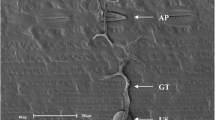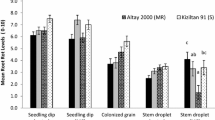Abstract
The relative resistance of 15 winter barley, three winter wheat and three winter oat cultivars on the UK recommended list 2003 and two spring wheat cultivars on the Irish 2003 recommended list were evaluated using Microdochium nivale in detached leaf assays to further understand components of partial disease resistance (PDR) and Fusarium head blight (FHB) resistance across cereal species. Barley cultivars showed incubation periods comparable to, and latent periods longer than the most FHB resistant Irish and UK wheat cultivars evaluated. In addition, lesions on barley differed from those on wheat as they were not visibly chlorotic when placed over a light box until sporulation occurred, in contrast to wheat cultivars where chlorosis of the infected area occurred when lesions first developed. The pattern of delayed chlorosis of the infected leaf tissue and longer latent periods indicate that resistances are expressed in barley after the incubation period is observed, and that these temporarily arrest the development of mycelium and sporulation. Incubation periods were longer for oats compared to barley or wheat cultivars. However, oat cultivars differed from both wheat and barley in that mycelial growth was observed before obvious tissue damage was detected under macroscopic examination, indicating tolerance of infection rather than inhibition of pathogen development, and morphology of sporodochia differed, appearing less well developed and being much less abundant. Longer latent periods have previously been related to greater FHB resistance in wheat. The present results suggest the longer latent periods of barley and oat cultivars, than wheat, are likely to play a role in overall FHB resistance if under the same genetic control as PDR components expressed in the head. However the limited range of incubation and latent periods observed within barley and oat cultivars evaluated was in contrast with wheat where incubation and latent periods were shorter and more variable among genotypes. The significance of the various combinations of PDR components detected in the detached leaf assay as components of FHB resistance in each crop requires further investigation, particularly with regard to the apparent tolerance of infection in oats and necrosis in barley, after the incubation period is observed, associated with retardation of mycelial growth and sporulation.
Similar content being viewed by others
References
OA Akinsanmi V Mitter S Simpfendorfer D Backhouse S Chakraborty (2004) ArticleTitleIdentity and pathogenicity of Fusarium spp. isolated from wheat fields in Queensland and northern New South Wales Australian Journal of Agricultural Research 55 97–107
RA Browne BM Cooke (2004a) ArticleTitleA new method for producing mycelium-free conidial suspensions from cultures of Microdochium nivale European Journal of Plant Pathology 110 87–90 Occurrence Handle1:CAS:528:DC%2BD3sXhtVWhsbbF
RA Browne BM Cooke (2004b) ArticleTitleDevelopment and evaluation of an in vitro detached leaf assay for pre-screening resistance to Fusarium head blight in wheat European Journal of Plant Pathology 110 91–102
RA Browne BM Cooke (2005) ArticleTitleResistance of wheat to Fusarium spp. in an in vitro seed germination assay and preliminary investigations into the relationship to Fusarium head blight resistance Euphytica 141 23–32
RA Browne JP Murphy BM Cooke D Devaney EJ Walsh CA Griffey JA Hancock SA Harrison P Hart FL Kolb AL McKendry EA Milus C Sneller DA Sanford ParticleVan (2005) ArticleTitleEvaluation of Fusarium head blight resistance in soft red winter wheat germplasm using a detached leaf assay Plant Disease 89 404–411
BM Cooke (1980) ArticleTitleThe use of coolplates for culturing photosporogenetic fungi Bulletin of the British Mycological Society 14 137–138
H Diamond BM Cooke B Dunne (1995) ArticleTitleMicrodochium Leaf Blotch of Oats – a new foliar disease caused by Microdochium nivale var. nivale in Ireland Plant Varieties and Seeds 8 171–174
H Diamond BM Cooke (1997a) ArticleTitleHost specialisation in Microdochium nivale on cereals Cereal Research Communications 25 533–538
H Diamond BM Cooke (1997b) ArticleTitleScanning electron microscope studies on Microdochium nivale Cereal Research Communications 25 583–584
H Diamond BM Cooke (1999) ArticleTitleTowards the development of a novel in vitro strategy for early screening of Fusarium ear blight resistance in adult winter wheat plants European Journal of Plant Pathology 105 363–372
Evans CK and Dill-Macky R (2003) Reaction of primary leaves of 26 wheat genotypes inoculated with macroconidia of Fusarium graminearum at the seedling stage and assessed for lesion length and deoxynivalenol accumulation at 96 H post-inoculation. In: Canty SM, Lewis J and Ward RW (eds). Proceedings of the National Fusarium Head Blight Forum; 2003 Dec 13–15; Bloomington, MN. Michigan State University, East Lansing, p. 138
W Gams E Muller (1980) ArticleTitleConidiogenesis of Fusarium nivale and Rhynchosporium oryzae and its taxonomic implications Netherlands Journal of Plant Pathology 86 45–53
L Gervais F Dedryver JY Morlais V Bodusseau S Negre M Bilous C Groos M Trottet (2003) ArticleTitleMapping of quantitative trait loci for field resistance to Fusarium head blight in an European winter wheat Theoretical and Applied Genetics 106 961–970 Occurrence Handle1:CAS:528:DC%2BD3sXisFCjsbg%3D Occurrence Handle12671743
J Gilbert A Tekauz R Kaethler B McCallum E Mueller U Kromer (1999) ArticleTitle1998 survey of Fusarium head blight in spring wheat in Manitoba Canadian Plant Disease Survey (electronic) 79 91
F Langevin F Eudes A Comeau (2004) ArticleTitleEffects of trichothecenes produced by Fusarium graminearum during Fusarium head blight development in six cereal species European Journal of Plant Pathology 110 735–746
W Liu W Langseth H Skinnes ON Elen L Sundheim (1997) ArticleTitleComparison of visual head blight ratings, seed infection levels, and deoxynivalenol production for assessment of resistance in cereals inoculated with Fusarium culmorum European Journal of Plant Pathology 103 589–595 Occurrence Handle1:CAS:528:DyaK2sXnt1Kisr8%3D
Mackintosh CA, Radmer LE, Jutila SL, Cyrus AC, Baldridge GD, Zeyen RJ, and Muehlbauer (2003) A transgenic approach to enhancing the resistance of wheat to Fusarium head blight. In: Canty SM, Lewis J and Ward RW (eds). Proceedings of the National Fusarium Head Blight Forum (p 26), 2003 Dec 13–15; Bloomington, MN: Michigan State University, East Lansing
RAP Malalaserkera FR Sanderson J Colhoun (1973) ArticleTitleFusarium diseases of cereals. IX Penetration and invasion of wheat seedlings by Fusarium culmorum and F. nivale Transactions of the British Mycological Society 60 453–462
B McCallum A Tekauz J Gilbert E Mueller R Kaethler M Stulzer U Kromer (1999) ArticleTitleFusarium head blight of barley in Manitoba in 1998 Canadian Plant Disease Survey (electronic) 79 73–74
DW Parry P Jenkinson L McLeod (1995) ArticleTitleFusarium ear blight (scab) in small grain cereals – a review Plant Pathology 44 207–238
DA Perry (1986) ArticleTitlePathogenicity of Monographella nivalis to spring barley Transactions of the British Mycological Society 86 287–293
DR Simpson HN Rezanoor DW Parry P Nicholson (2000) ArticleTitleEvidence for differential host preference in Microdochium nivale var. majus and Microdochium nivale var. nivale Plant Pathology 49 261–268
BJ Steffenson (2003) Fusarium head blight of barley: Impact of epidemics, management and strategies for identifying and utilizing genetic resistance KJ Leonard WR Bushnell (Eds) Fusarium Head Blight of Wheat and Barley The American Phytopathological Society St. Paul Minnesota 241–295
Tekauz A (1999) Fusarium head blight of barley: a plant␣pathologist’s perspective. In: Proceedings Canadian Barley Symposium 99, (pp 87–93) 23–25 February 1999, Winnipeg, Manitoba. Canadian International Grains Institute
HW Wollenweber (1931) Fusarium – Monographie Julius Springer Berlin 516
Author information
Authors and Affiliations
Corresponding author
Rights and permissions
About this article
Cite this article
Browne, R., Cooke, B. A comparative assessment of potential components of partial disease resistance to Fusarium head blight using a detached leaf assay of wheat, barley and oats . Eur J Plant Pathol 112, 247–258 (2005). https://doi.org/10.1007/s10658-005-2077-z
Accepted:
Issue Date:
DOI: https://doi.org/10.1007/s10658-005-2077-z




